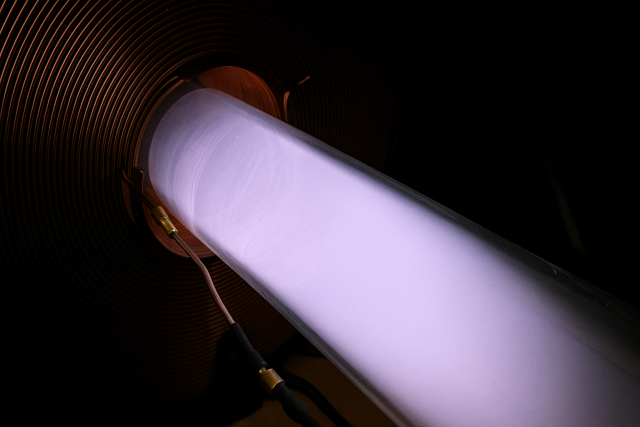We’re redefining air-breathing electric propulsion (ABEP) — breaking away from convention with a radically new approach. Instead of adapting existing xenon-based thrusters for atmospheric use, we are designing a fundamentally new ionization source tailored specifically to the unique conditions of VLEO.
This novel plasma generation technology is being developer in cooperation with Department of Theoretical and Experimental Electrical Engineering and PlasmaSolve with three critical goals in mind:
- Operation at extremely-low pressures — optimized for the rarefied environment of VLEO (on the order of 10⁻⁴ Pa)
- High power transfer efficiency — to minimize onboard power demands
- Scalability — enabling higher thrust levels for different mission classes
The residual atmosphere at VLEO, though sparse, is denser than the high vacuum of conventional low Earth orbit. This changes everything. To capitalize on it, we use validated simulation tools to study how atmospheric gases interact with spacecraft surfaces. These simulations allow us to accurately model key factors like drag, gas compression, and attitude disturbance due to asymmetrical flow — crucial for optimizing system performance and control.
Gas compression at VLEO conditions
Our innovation is grounded in deep theoretical expertise in plasma science. Ionizing atmospheric gases — particularly oxygen, or mixed compositions like O/N₂/O₂/N — is far more complex than working with noble gases like xenon. Even for simple VLEO air mixtures, dozens of plasma reactions must be taken into account to accurately model behavior and design a functional system.
Our team includes specialists in plasma dynamics and simulation who develop detailed numerical models of plasma behavior in VLEO-like conditions. These simulations directly inform the architecture and operation of our custom plasma source.
While our early work focused on modeling and theoretical groundwork, we’re now transitioning to hardware — and seeing promising results. We are proud to share that the second-generation prototype of SpaceLabEU’s ABEP ionization source is operational. Preliminary testing indicates that it meets all key performance requirements, validating both our theoretical models and our design strategy.

We’re just getting started. Follow us for updates as we move from simulations to flight-ready systems — and keep an eye out for new breakthroughs, collaborations, and results!


